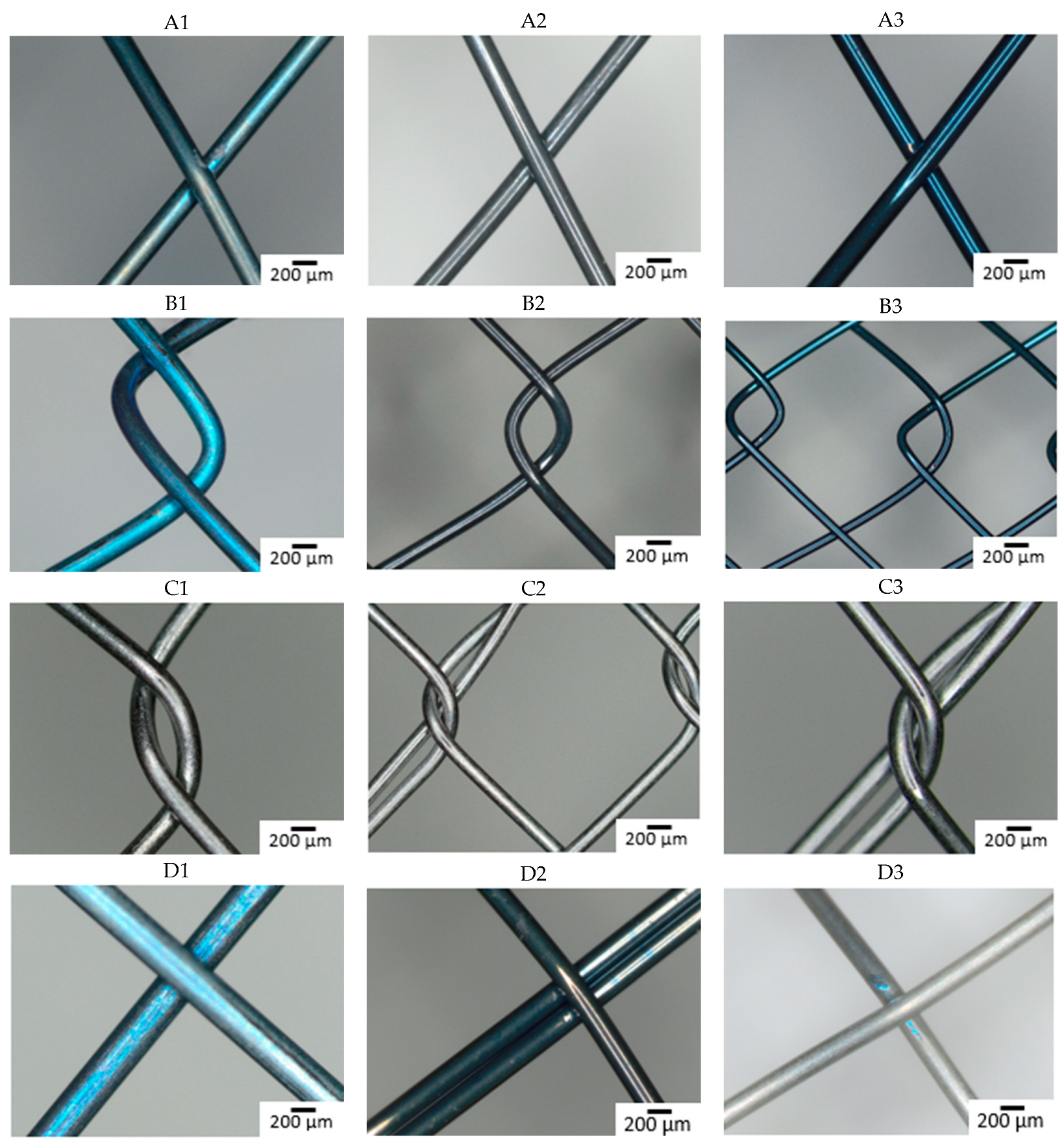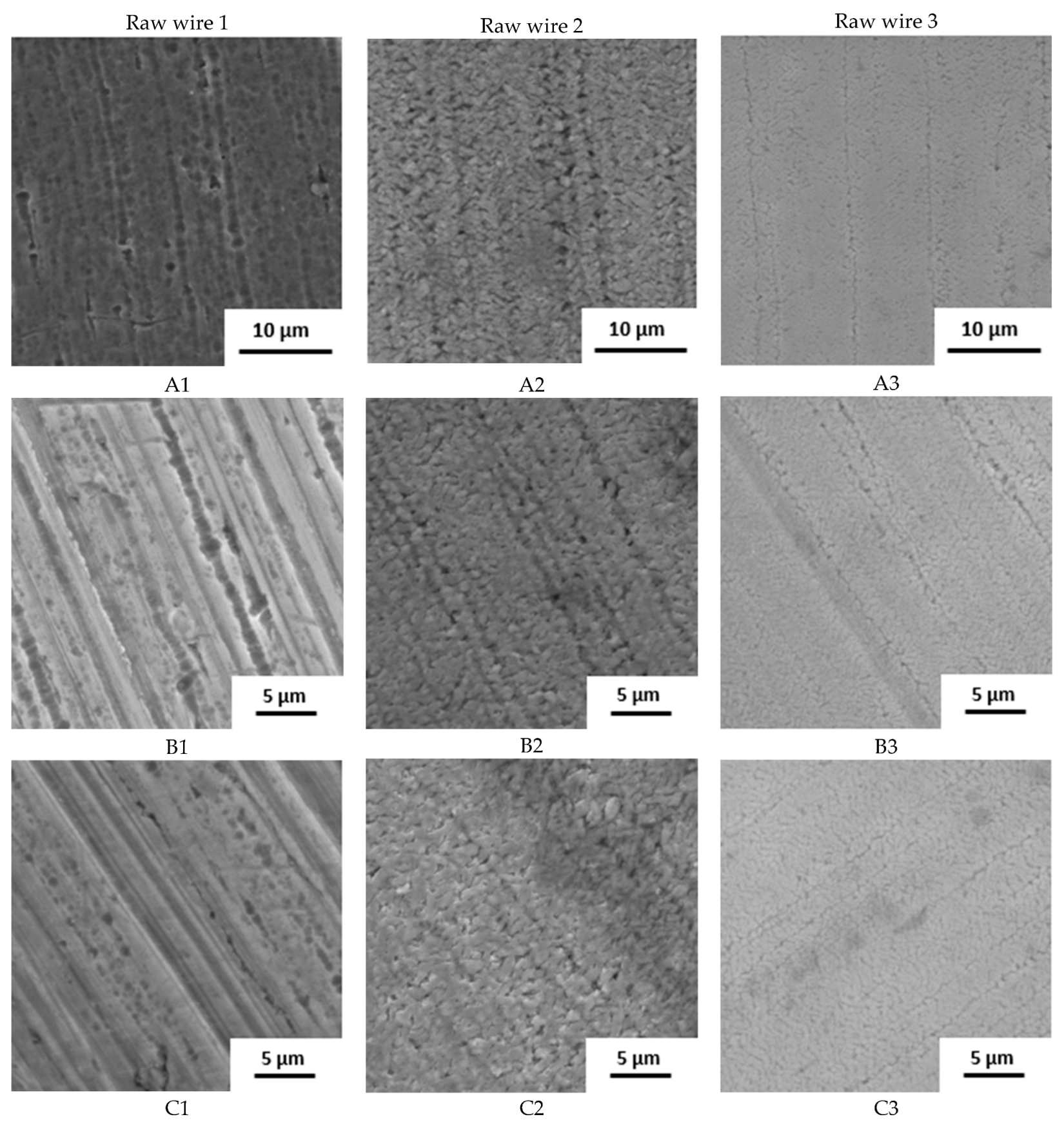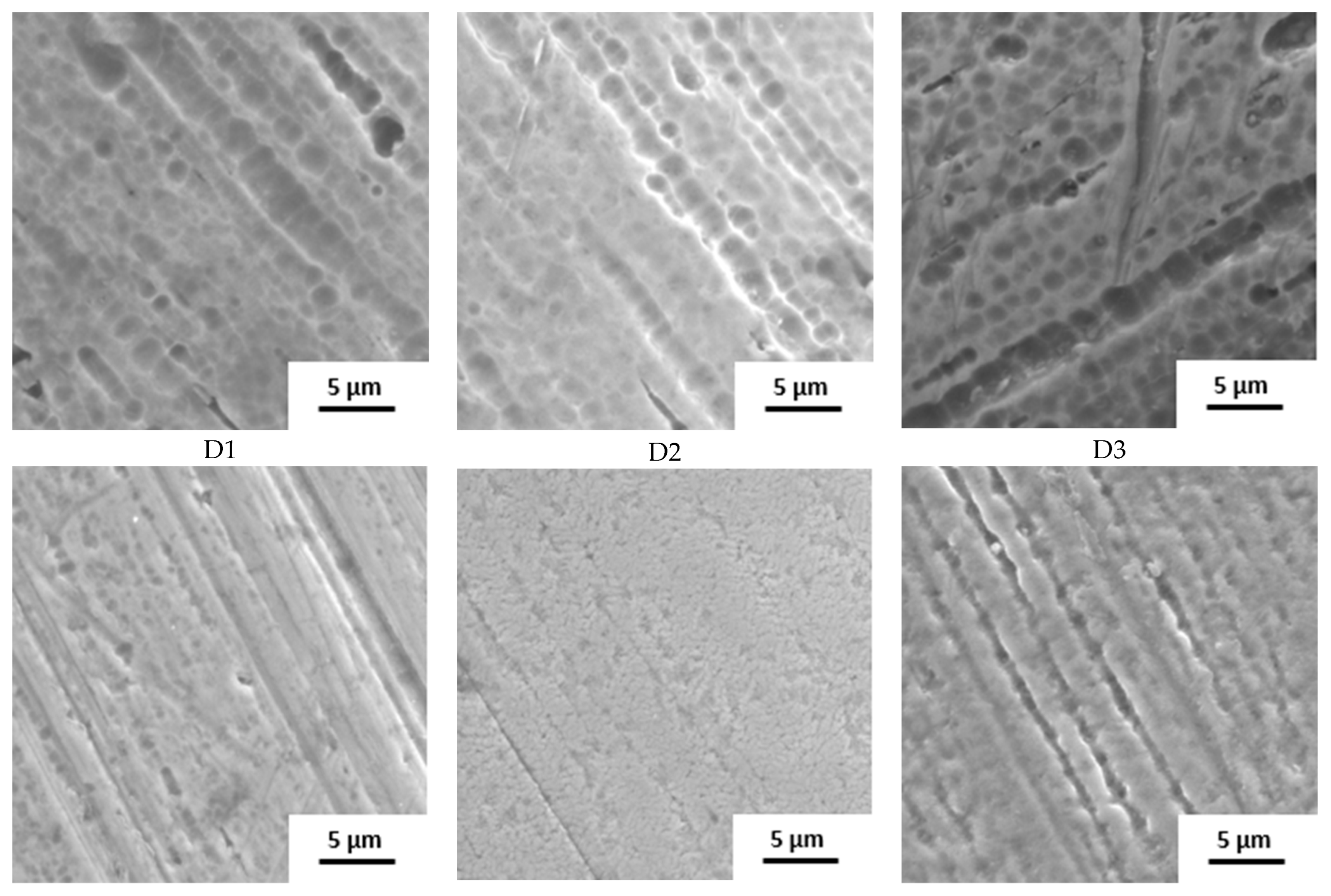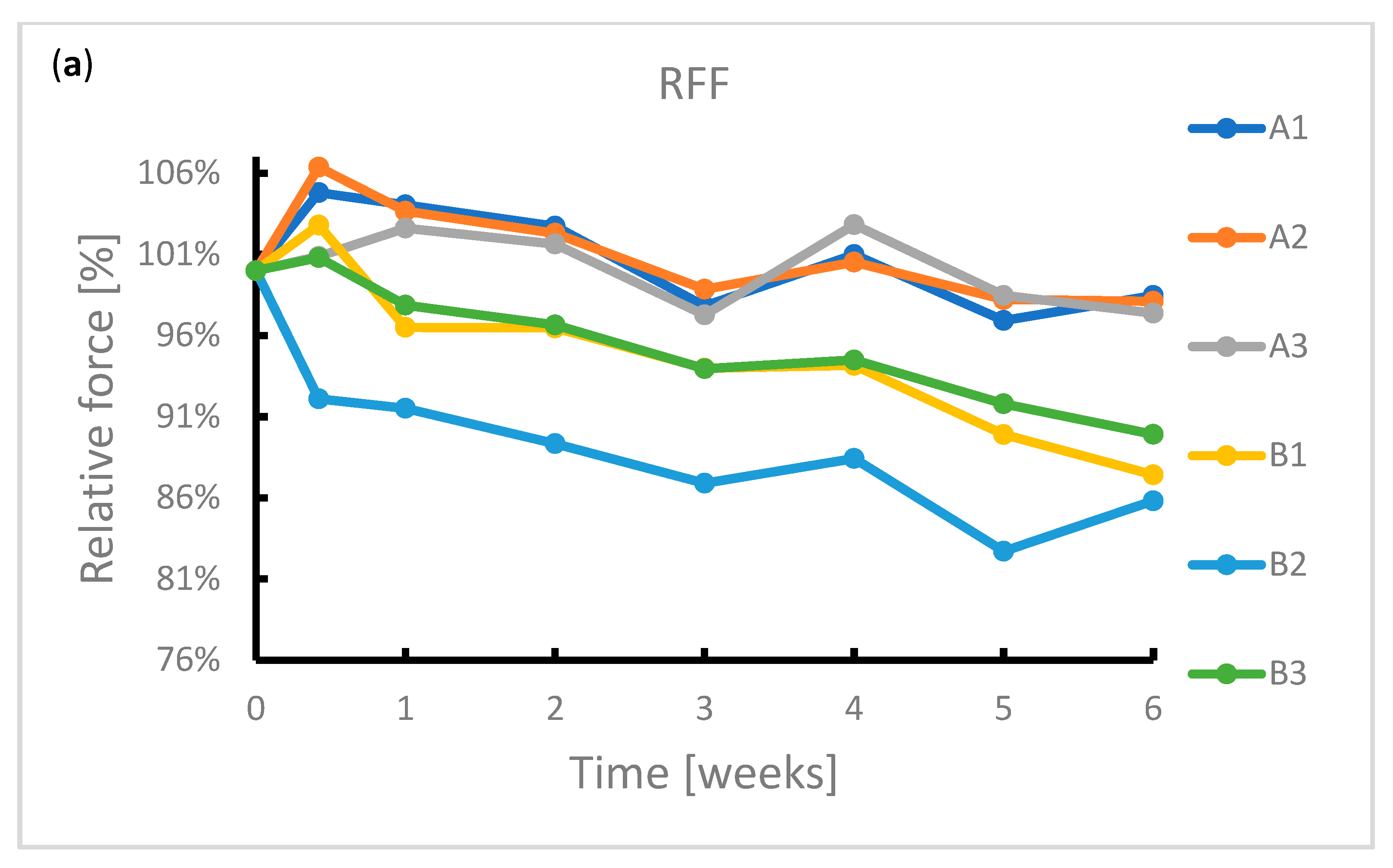Influence of the Manufacturing Process on the Corrosion and Mechanical Behavior of Esophageal Stents
Abstract
1. Introduction
2. Materials and Methods
3. Results
3.1. Surface State
3.2. Immersion in SGF—Corrosion Behavior
3.3. Immersion in SGF—Radial Forces Measurement
4. Discussion
5. Conclusions
Author Contributions
Funding
Data Availability Statement
Acknowledgments
Conflicts of Interest
References
- Provan, J.L. Use of Celestin tube for palliation of malignant oesophageal obstruction. Thorax 1969, 24, 599–602. [Google Scholar] [CrossRef][Green Version]
- Hirdes, M.M.; Vleggaar, F.P.; de Beule, M.; Siersema, P.D. In vitro evaluation of the radial and axial force of self-expanding esophageal stents. Endoscopy 2013, 45, 997–1005. [Google Scholar] [CrossRef]
- Mbah, N.; Philips, P.; Voor, M.J.; Martin, R.C.G., 2nd. Optimal radial force and size for palliation in gastroesophageal adenocarcinoma: A comparative analysis of current stent technology. Surg. Endosc. 2017, 31, 5076–5082. [Google Scholar] [CrossRef]
- Laasch, H.-U.; Milward, G.D.; Edwards, D.W. ‘Radial force’ of colonic stents: A parameter without consistency, definition or standard. Int. J. Gastrointest. Interv. 2020, 9, 99–105. [Google Scholar] [CrossRef]
- Hindy, P.; Hong, J.; Lam-Tsai, Y.; Gress, F. A comprehensive review of esophageal stents. Gastroenterol. Hepatol. 2012, 8, 526–534. [Google Scholar]
- Liang, D.H.; Hwang, E.; Meisenbach, L.M.; Kim, M.P.; Chan, E.Y.; Khaitan, P.G. Clinical outcomes following self-expanding metal stent placement for esophageal salvage. J. Thorac. Cardiovasc. Surg. 2017, 154, 1145–1150. [Google Scholar] [CrossRef]
- Stoeckel, D.; Pelton, A.; Duerig, T. Self-expanding nitinol stents: Material and design considerations. Eur. Radiol. 2004, 14, 292–301. [Google Scholar] [CrossRef]
- Kocich, R.; Szurman, I.; Kursa, M. The methods of preparation of Ti–Ni–X alloys and their forming. In Shape Memory Alloys-Processing, Characterization and Applications; IntechOpen: London, UK, 2013; pp. 28–35. [Google Scholar] [CrossRef]
- Shiva, S.; Palani, I.A.; Mishra, S.K.; Paul, C.P. Investigations on the influence of composition in the development of Ni–Ti shape memory alloy using laser based additive manufacturing. Opt. Laser Technol. 2015, 69, 44–51. [Google Scholar] [CrossRef]
- Sun, F.; Jordan, L.; Albin, V.; Lair, V.; Ringuedé, A.; Prima, F. On the High Sensitivity of Corrosion Resistance of NiTi Stents with Respect to Inclusions: An Experimental Evidence. ACS Omega 2020, 5, 3073–3079. [Google Scholar] [CrossRef]
- Kanca, M.S.; Kök, M.; Qader, I.N. Corrosion behavior and crystal-microstructural analysis of non-equiatomic NiTi shape memory alloys. J. Therm. Anal. Calorim. 2022, 147, 1–11. [Google Scholar] [CrossRef]
- Martinez, A.L.; Saugo, M.; Flamini, D.O.; Saidman, S.B. Enhancing the corrosion behavior of Ti–6Al–4V and Nitinol alloys by simple chemical oxidation in H2O2. Mater. Chem. Phys. 2023, 295, 127069. [Google Scholar] [CrossRef]
- Vojtech, D.; Joska, L.; Leitner, J. Influence of a controlled oxidation at moderate temperatures on the surface chemistry of nitinol wire. Appl. Surf. Sci. 2008, 254, 5664–5669. [Google Scholar] [CrossRef]
- Vojtěch, D.; Voděrová, M.; Kubásek, J.; Novák, P.; Šedá, P.; Michalcová, A.; Fojt, J.; Hanuš, J.; Mestek, O. Effects of short-time heat treatment and subsequent chemical surface treatment on the mechanical properties, low-cycle fatigue behavior and corrosion resistance of a Ni–Ti (50.9at.% Ni) biomedical alloy wire used for the manufacture of stents. Mater. Sci. Eng. A 2011, 528, 1864–1876. [Google Scholar] [CrossRef]
- Zhu, L.; Pelton, A.R.; Fino, J.M. Oxidation of nitinol and its effect on corrosion resistance. In Proceedings of the ASM Materials & Processes for Medical Device Conference, St. Paul, MN, USA, 25–27 August 2004; pp. 156–161. [Google Scholar]
- Ohtsu, N.; Hirano, Y.; Yamaguchi, K.; Yamasaki, K. Surface characteristics, Ni ion release, and antibacterial efficacy of anodized NiTi alloy using HNO3 electrolyte of various concentrations. Appl. Surf. Sci. 2019, 492, 785–791. [Google Scholar] [CrossRef]
- Wu, G.; Li, L.; Sun, M.; Wang, Y.; Luo, F.; Zhang, Q.; Liu, R.; Chen, Z.; Yao, J. Microstructural evolution and biological properties of PEO coating on SLM-prepared NiTi alloy. Surf. Coat. Technol. 2023, 452, 129065. [Google Scholar] [CrossRef]
- Hassel, A.W. Surface treatment of NiTi for medical applications. Minim. Invasive Ther. Allied Technol. 2004, 13, 240–247. [Google Scholar] [CrossRef]
- Dos Reis Barros, C.D.; Gomes, J.A.d.C.P. Strain induced localized corrosion of NiTi, NiTiCo and NiTiCr alloys in 0.9% NaCl. J. Mech. Behav. Biomed. Mater. 2020, 112, 104015. [Google Scholar] [CrossRef]
- Khara, H.S.; Diehl, D.L.; Gross, S.A. Esophageal stent fracture: Case report and review of the literature. World J. Gastroenterol. 2014, 20, 2715–2720. [Google Scholar] [CrossRef]
- Wiedmann, M.; Heller, F.; Zeitz, M.; Mössner, J. Fracture of a covered self-expanding antireflux stent in two patients with distal esophageal carcinoma. Endoscopy 2009, 41 (Suppl. S2), E129–E130. [Google Scholar] [CrossRef]
- Rana, S.S.; Bhasin, D.K.; Sidhu, G.S.; Rawal, P.; Nagi, B.; Singh, K. Esophageal nitinol stent dysfunction because of fracture and collapse. Endoscopy 2009, 41 (Suppl. S2), E170–E171. [Google Scholar] [CrossRef]
- Wadsworth, C.A.; East, J.E.; Hoare, J.M. Early covered-stent fracture after placement for a benign esophageal stricture. Gastrointest. Endosc. 2010, 72, 1260–1261. [Google Scholar] [CrossRef] [PubMed]
- Shokri, N.; Safavi, M.S.; Etminanfar, M.; Walsh, F.C.; Khalil-Allafi, J. Enhanced corrosion protection of NiTi orthopedic implants by highly crystalline hydroxyapatite deposited by spin coating: The importance of pre-treatment. Mater. Chem. Phys. 2021, 259, 124041. [Google Scholar] [CrossRef]
- Nagaraja, S.; Sullivan, S.J.L.; Stafford, P.R.; Lucas, A.D.; Malkin, E. Impact of nitinol stent surface processing on in-vivo nickel release and biological response. Acta Biomater. 2018, 72, 424–433. [Google Scholar] [CrossRef] [PubMed]
- Kay, L. Cyclic Potentiodynamic Survey of Medical Materials. Master’s Thesis, Purdue University Fort Wayne Campus, Fort Wayne, IN, USA, 2010. [Google Scholar]
- Carlson, T.A.; McGuire, G. Study of the X-ray photoelectron spectrum of tungsten—Tungsten oxide as a function of thickness of the surface oxide layer. J. Electron Spectrosc. Relat. Phenom. 1972, 1, 161–168. [Google Scholar] [CrossRef]
- Strohmeier, B.R. An ESCA method for determining the oxide thickness on aluminum alloys. Surf. Interface Anal. 1990, 15, 51–56. [Google Scholar] [CrossRef]
- ASTM Standard F2528-06; Standard Test Methods for Enteral Feeding Devices with a Retention Balloon. ASTM International: West Conshohocken, PA, USA, 2006.
- Pandolfino, J.E.; Richter, J.E.; Ours, T.; Guardino, J.M.; Chapman, J.; Kahrilas, P.J. Ambulatory esophageal pH monitoring using a wireless system. Am. J. Gastroenterol. 2003, 98, 740–749. [Google Scholar] [CrossRef] [PubMed]
- Washington, N.; Steele, R.J.; Wright, J.W.; Bush, D.; McIntosh, S.L.; Wilkinson, S.; Washington, C. An investigation of lower oesophageal redox potentials in gastro-oesophageal reflux patients and healthy volunteers. Physiol. Meas. 1997, 18, 363–371. [Google Scholar] [CrossRef]
- Kaltsidis, H.; Mansoor, W.; Park, J.H.; Song, H.Y.; Edwards, D.W.; Laasch, H.U. Oesophageal stenting: Status quo and future challenges. Br. J. Radiol. 2018, 91, 20170935. [Google Scholar] [CrossRef]
- De Almeida, B.; Elias, C. Influence of heat treatment on color and flexibility of nickel-titanium endodontic instruments. RGO Rev. Gaúcha Odontol. 2020, 68, e20200044. [Google Scholar] [CrossRef]
- Furukawa Techno Material Co., Ltd. Ni-Ti Tubes for Medical Devices. Available online: https://www.furukawa-ftm.com/tokusyu/english/wp-content/themes/furukawa/assets/pdf/Ni-Ti_tube.pdf (accessed on 15 May 2023).
- Fort Wayne Metals. Nitinol. Available online: https://www.fwmetals.com/materials/nitinol/ (accessed on 15 May 2023).
- Patel, M.M.; Gordon, R.F. An investigation of diverse surface finishes on fatigue properties of superelastic Nitinol wire. In Proceedings of the International Conference on Shape Memory and Superelastic Technologies, SMST-2006, Pacific Grove, CA, USA, 7–11 May 2006; pp. 7–11. [Google Scholar]
- PEIERTECH. Nitinol Round Wires Lingual Arch Wire NiTi Wire for Orthodontic. Available online: https://www.peiertech.cn/Nitinol-Round-Wires-Lingual-Arch-Wire-NiTi-Wire-for-Orthodontic-pd48474233.html (accessed on 15 May 2023).
- Vojtěch, D.; Fojt, J.; Joska, L.; Novák, P. Surface treatment of NiTi shape memory alloy and its influence on corrosion behavior. Surf. Coat. Technol. 2010, 204, 3895–3901. [Google Scholar] [CrossRef]
- Ding, R.; Shang, J.-X.; Wang, F.-H.; Chen, Y. Electrochemical Pourbaix diagrams of NiTi alloys from first-principles calculations and experimental aqueous states. Comput. Mater. Sci. 2018, 143, 431–438. [Google Scholar] [CrossRef]
- Clarke, B.; Carroll, W.; Rochev, Y.; Hynes, M.; Bradley, D.; Plumley, D. Influence of Nitinol wire surface treatment on oxide thickness and composition and its subsequent effect on corrosion resistance and nickel ion release. J. Biomed. Mater. Res. Part A 2006, 79A, 61–70. [Google Scholar] [CrossRef] [PubMed]
- Ogawa, T.; Yokozawa, E.; Oda, T.; Maruoka, K.; Sakai, J.i. Hydrogen embrittlement behavior of Ni-Ti shape memory alloy with different microstructures in acidic fluoride solution. Int. J. Mech. Mater. Eng. 2015, 10, 12. [Google Scholar] [CrossRef]
- Volenec, K.; Pohl, I. The challenges: Stent materials from the perspective of the manufacturer. Gastrointest. Interv. 2016, 5, 98–104. [Google Scholar] [CrossRef]







| Component | Concentration |
|---|---|
| NaCl | 2 g/L |
| Pepsin | 3.2 g/L |
| HCl | 7 mL/L |
| Setting Parameters | Manufacturer A | Manufacturer B | Manufacturer C | Manufacturer D |
|---|---|---|---|---|
| Initial diameter (mm) | 25 | 25 | 25 | 28 |
| Final diameter (mm) | 4 | 4 | 7.8 | 4 |
| Number of cycles | 1 | 1 | 1 | 1 |
| Sample | Original Surface | After 6 Weeks | ||||
|---|---|---|---|---|---|---|
| Ti (at. %) | Ni (at. %) | TiO2 Thickness (nm) | Ti (at. %) | Ni (at. %) | TiO2 Thickness (nm) | |
| wire 1 | 96.8 | 3.2 | 8.8 | - | - | - |
| wire 2 | 67.4 | 32.6 | ≥10 | - | - | - |
| wire 3 | 98.3 | 1.7 | ≥10 | - | - | - |
| A1 | 96.6 | 3.4 | ≥10 | 97 | 3 | ≥10 |
| A2 | 85.8 | 14.2 | ≥10 | 100 | 0 | ≥10 |
| A3 | 81.4 | 18.6 | ≥10 | 100 | 0 | ≥10 |
| B1 | 94.5 | 5.5 | ≥10 | 95.1 | 4.9 | ≥10 |
| B2 | 82.1 | 17.9 | ≥10 | 89.3 | 10.7 | 9 |
| B3 | 88.5 | 11.5 | ≥10 | 94.8 | 5.2 | ≥10 |
| C1 | 92.2 | 7.8 | 8.7 | 94 | 6 | 8.9 |
| C2 | 92.5 | 7.5 | 7.8 | 93.1 | 6.9 | 8.2 |
| C3 | 94.4 | 5.6 | 7.8 | 92.5 | 7.5 | 7.8 |
| D1 | 89.7 | 10.3 | ≥10 | 95.3 | 4.7 | ≥10 |
| D2 | 94.8 | 5.2 | ≥10 | 97 | 3 | ≥10 |
| D3 | 86.6 | 13.4 | 6.9 | 91.3 | 8.7 | 8.4 |
| Manufacturer Wire | A | B | C | D |
|---|---|---|---|---|
| 1 | 1 week | 2 weeks | not detected | 1 week |
| 2 | 1 week | 3 days | 5 weeks | 3 weeks |
| 3 | 1 week | 2 weeks | 4 weeks | 1 week |
| Sample | Ni (ppm) | Ti (ppm) |
|---|---|---|
| A1 | 0.35 | --- |
| A2 | 3.93 | 2 |
| A3 | 0.4 | --- |
| B1 | 0.18 | --- |
| B2 | 14.4 | 9 |
| B3 | 0.37 | --- |
| C1 | <0.1 | --- |
| C2 | <0.1 | --- |
| C3 | <0.1 | --- |
| D1 | 0.3 | --- |
| D2 | 0.5 | --- |
| D3 | 0.1 | --- |
| OCP | Rp | OCP | Rp | OCP | Rp |
|---|---|---|---|---|---|
| mV/SSCE | Ω cm2 | mV/SSCE | Ω cm2 | mV/SSCE | Ω cm2 |
| A1 | A2 | A3 | |||
| −89 ± 9 | 3·105 ± 8·104 | −115 ± 45 | 2·104 ± 1·104 | −88 ± 12 | 3·105 ± 2·105 |
| B1 | B2 | B3 | |||
| 37 ± 92 | 5·105 ± 4·105 | −63 ± 14 | 4·103 ± 9·102 | −71 ± 6 | 9·104 ± 3·104 |
| C1 | C2 | C3 | |||
| −55 ± 27 | 6·105 ± 2·105 | −60 ± 15 | 6·105 ± 2·105 | −42 ± 17 | 5·105 ± 1·105 |
| D1 | D2 | D3 | |||
| 86 ± 21 | 4·105 ± 1·105 | 35 ± 36 | 4·105 ± 9·104 | 28 ± 10 | 7·105 ± 2·105 |
| 1 | 2 | 3 | |||
| 12 ± 61 | 2·106 ± 1·106 | −44 ± 45 | 1·104 ± 6·103 | 91 ± 26 | 2·106 ± 5·105 |
Disclaimer/Publisher’s Note: The statements, opinions and data contained in all publications are solely those of the individual author(s) and contributor(s) and not of MDPI and/or the editor(s). MDPI and/or the editor(s) disclaim responsibility for any injury to people or property resulting from any ideas, methods, instructions or products referred to in the content. |
© 2023 by the authors. Licensee MDPI, Basel, Switzerland. This article is an open access article distributed under the terms and conditions of the Creative Commons Attribution (CC BY) license (https://creativecommons.org/licenses/by/4.0/).
Share and Cite
Alferi, D.; Fojt, J.; Kristianova, E.; Edwards, D.W.; Laasch, H.-U. Influence of the Manufacturing Process on the Corrosion and Mechanical Behavior of Esophageal Stents. Metals 2023, 13, 1542. https://doi.org/10.3390/met13091542
Alferi D, Fojt J, Kristianova E, Edwards DW, Laasch H-U. Influence of the Manufacturing Process on the Corrosion and Mechanical Behavior of Esophageal Stents. Metals. 2023; 13(9):1542. https://doi.org/10.3390/met13091542
Chicago/Turabian StyleAlferi, Dino, Jaroslav Fojt, Eva Kristianova, Derek W. Edwards, and Hans-Ulrich Laasch. 2023. "Influence of the Manufacturing Process on the Corrosion and Mechanical Behavior of Esophageal Stents" Metals 13, no. 9: 1542. https://doi.org/10.3390/met13091542
APA StyleAlferi, D., Fojt, J., Kristianova, E., Edwards, D. W., & Laasch, H.-U. (2023). Influence of the Manufacturing Process on the Corrosion and Mechanical Behavior of Esophageal Stents. Metals, 13(9), 1542. https://doi.org/10.3390/met13091542





